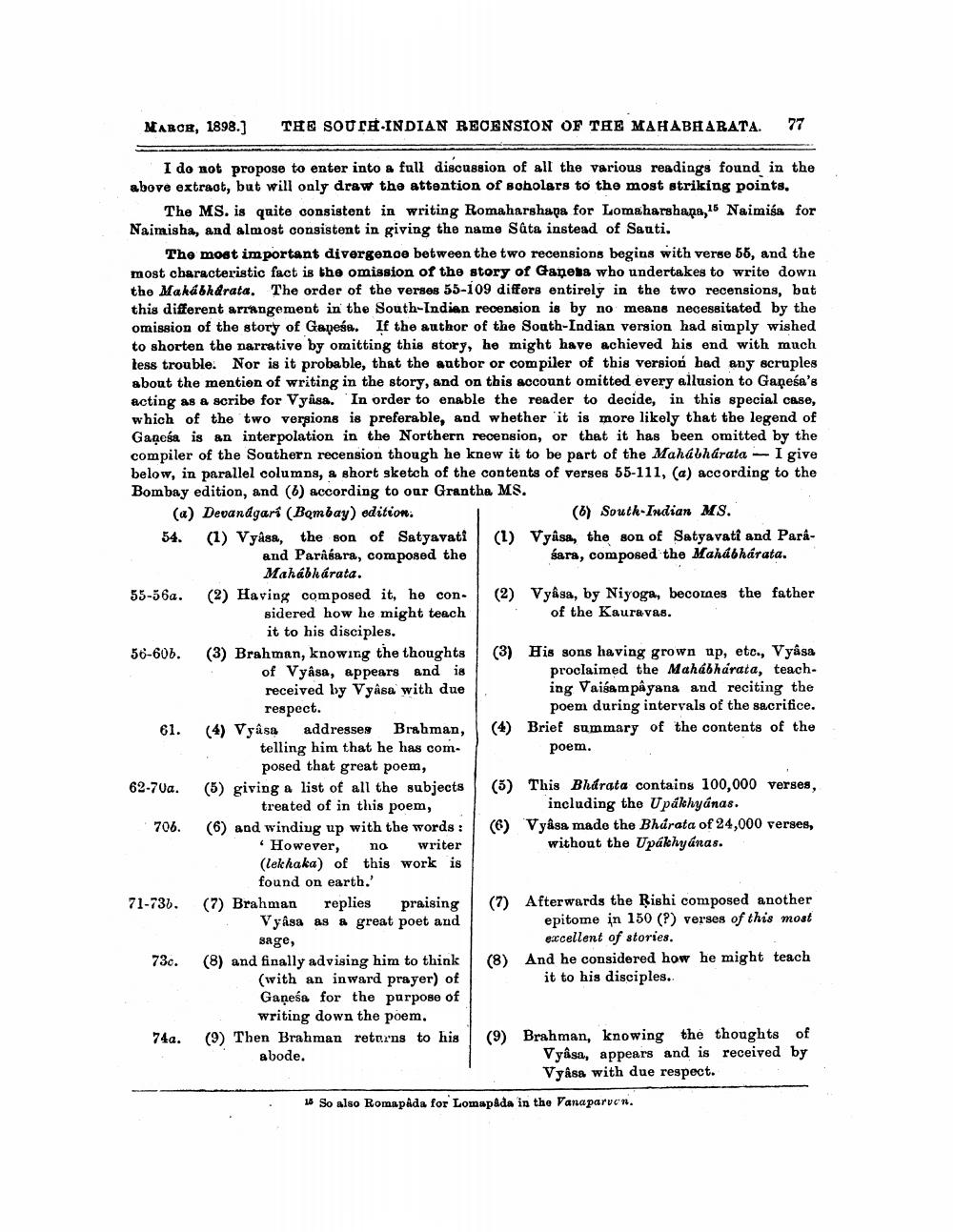________________
MARCR, 1898.]
THE SOUTH INDIAN RECENSION OF THE MAHABHARATA. 77
I do not propose to enter into a full discussion of all the various readings found in the above extract, but will only draw the attention of sobolars to the most striking points,
The MS. is quite consistent in writing Romaharshapa for Lomaharshapa, 15 Naimisa for Naimisha, and almost consistent in giving the name Säta instead of Sauti.
The most important divergence between the two recensions begins with verse 55, and the most characteristic fact is the omission of the story of Ganebs who undertakes to write down the Makábkdrata. The order of the verses 55-109 differs entirely in the two recensions, bat this different arrangement in the South-Indian recension is by no means necessitated by the omission of the story of Gapesa. If the author of the South-Indian version had simply wished to shorten the narrative by omitting this story, he might have achieved his end with much tess trouble. Nor is it probable, that the author or compiler of this version had any scruples about the mention of writing in the story, and on this account omitted every allusion to Gapeśa's acting as a scribe for Vyasa. In order to enable the reader to decide, in this special case, which of the two versions is preferable, and whether it is more likely that the legend of Gaņeśa is an interpolation in the Northern recension, or that it has been omitted by the compiler of the Southern recension though he knew it to be part of the Mahabharata - I give below, in parallel columns, & short sketch of the contents of verses 55-111, (a) according to the Bombay edition, and (6) according to our Grantha MS. (a) Devandgari (Bombay) edition.
(6) South Indian MS. 54. (1) Vyâsa, the son of Satyavati (1) Vyâsa, the son of Satyavatî and Paraand Parasara, composed the
sara, composed the Mahabharata. Mahabharata. 55-56a. (2) Having composed it, he con- (2) Vyâsa, by Niyoga, becomes the father sidered how he might teach
of the Kauravas. it to his disciples. 56-605. (3) Brahman, knowing the thoughts (3) His sons having grown up, etc., Vyasa of Vyâsa, appears and is
proclaimed the Mahabharata, teachreceived by Vyasa with due
ing Vaisampayana and reciting the respect.
poem during intervals of the sacrifice. 61. (4) Vyâsa addresses Brahman, (4) Brief summary of the contents of the telling him that he has com.
poem. posed that great poem, 62-70a. (5) giving a list of all the subjects
(5) This Bharata contains 100,000 verses, treated of in this poem,
including the Upályánas. 706. (6) and winding up with the words : (6) Vyasa made the Bhúrata of 24,000 verses, However, no writer
without the Upákhyánas. (lek haka) of this work is
found on earth. 71-736. (7) Brahman replies praising (7) Afterwards the Rishi composed another Vyasa as a great poet and
epitome in 150 (?) verses of this most sage,
excellent of stories. 730. (8) and finally advising him to think (8) And he considered how he might teach (with an inward prayer) of
it to his disciples. Gaņeśa for the purpose of
writing down the poem. 749. (9) Then Brahman returns to his (9) Brahman, knowing the thoughts of abode.
Vyâsa, appears and is received by Vyâss with due respect.
:
15 So also Romapida for Lomapada in the Vanaparven.




